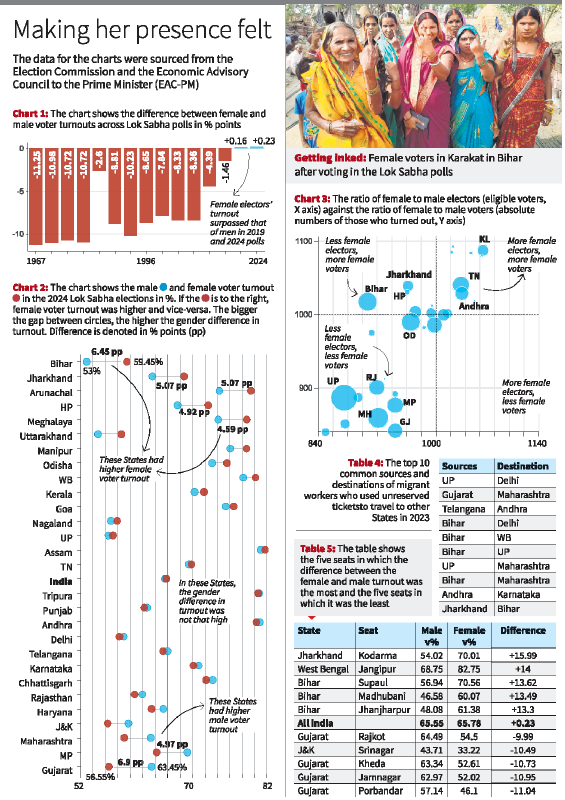- Courses
- GS Full Course 1 Year
- GS Full Course 2 Year
- GS Full Course 3 Year
- GS Full Course Till Selection
- Online Program
- GS Recorded Course
- NCERT (Recorded 500+ Hours)
- Polity Recorded Course
- Geography Recorded Course
- Economy Recorded Course
- AMAC Recorded Course
- Modern India, Post Independence & World History
- Environment Recoded Course
- Governance Recoded Course
- Science & Tech. Recoded Course
- International Relations and Internal Security Recorded Course
- Disaster Management Module Course
- Ethics Recoded Course
- Essay Recoded Course
- Current Affairs Recoded Course
- CSAT
- 5 LAYERED ARJUNA Mentorship
- Public Administration Optional
- ABOUT US
- OUR TOPPERS
- TEST SERIES
- FREE STUDY MATERIAL
- VIDEOS
- CONTACT US
Female Voter Turnout Exceeds Male in 2024 Lok Sabha Elections
Female Voter Turnout Exceeds Male in 2024 Lok Sabha Elections
02-01-2025

- In December 2024, Election Commission of India released the data on the 2024 Lok Sabha elections which has shed light on an important trend.
- The data shows that female voter turnout has surpassed male turnout for the 2nd consecutive time, indicating a significant shift in India's electoral dynamics.
- Female electors accounted for 48.62% of the total electorate in 2024, up from 48.09% in 2019.
- The total number of registered electors increased by 7.43% to nearly 98 crore, with 64.64 crore votes cast.

Trends in Female Voter Turnout
- Narrowing Gender Gap: The gap between male and female turnout has been steadily narrowing over recent elections.
- In both 2019 and 2024, female turnout overtook male turnout, a trend attributed to increased political awareness and mobilization among women.
- The gender gap in turnout widened from 0.16 percentage points in 2019 to 0.23 points in 2024.
-
State-Wise Trends:
- Higher Female Turnout: States such as Bihar, Jharkhand, Uttarakhand, Arunachal Pradesh, Meghalaya, Manipur, and West Bengal saw a higher proportion of women voters compared to men.
- Higher Male Turnout: In contrast, states like Gujarat, Maharashtra, Jammu & Kashmir, Rajasthan, Madhya Pradesh, Telangana, and Karnataka recorded higher male turnout.
- Female voter turnout exceeded male turnout in 15 out of 28 major states and union territories (UTs).
Electorate Composition and Turnout Ratios
- Female Voters Outnumber Males: In states like Tamil Nadu, Kerala, and Andhra Pradesh, the number of registered female electors exceeded that of males, resulting in higher female turnout.
- Higher Turnout Despite Fewer Electors: Bihar stands out as a state where women outnumbered men in turnout despite having fewer registered female electors. Similar trends were observed in Jharkhand and Himachal Pradesh.
- Male-Dominated States: In Gujarat and Madhya Pradesh, male voters dominated both the electorate and the turnout, maintaining traditional patterns.
Factors Influencing Gender-Based Turnout
-
Migration Patterns:
- Male Out-Migration: States like Bihar and Jharkhand witness significant male out-migration for employment, often to distant states, which prevents many male voters from returning to their home states to cast their votes.
- Data Correlation: Migration data from 2023 reveals Bihar as a leading source state for migrant workers, with several non-neighbouring states as key destinations.
-
Political Engagement:
- Targeted campaigns and mobilization efforts aimed at women voters have likely contributed to the rising female turnout. These efforts include addressing women-centric issues and increasing their political awareness.
-
Structural Factors:
- Socioeconomic structures and policies supporting women’s participation in elections have played a role in narrowing the gender gap.
Additional Data Highlights
- Polling Stations: The number of polling stations increased to around 10,52,600 in 2024, with Bihar adding the highest number (4,739).
- Repolls were conducted in only 40 polling stations (0.0038% of total), a significant decrease from 540 in 2019.
- Inclusivity and Representation: Transgender electors rose by 23.5% to 48,272, with turnout nearly doubling to 27.09% from 14.64% in 2019.
- The number of registered persons with disabilities (PwD) electors increased to 90.29 lakh.
- Female electors per 1,000 male electors increased from 926 in 2019 to 946 in 2024.
- Women Empowerment: Female voter turnout reached significant highs in constituencies like Dhubri (Assam) at 92.17% and Tamluk (West Bengal) at 87.57%.
- Puducherry recorded the highest percentage of female electors at 53.03%.
- Nominations and Results: Women made up a growing share of candidates, with Maharashtra leading (111 female candidates), followed by Uttar Pradesh (80) and Tamil Nadu (77).
- Of the 3,921 independent candidates, only 7 were elected, with women receiving 2.79% of the total valid votes.
Implications and Policy Recommendations
- Migration and Voting Rights: Addressing the challenges of migrant workers’ voting participation is critical. Strategies like facilitating remote voting or special provisions for migrant workers could help bridge this gap.
- Gender-Inclusive Policies: Encouraging female political participation through targeted awareness campaigns and ensuring women-centric policy frameworks can further enhance turnout.
- Data-Driven Research: Further analysis of migration data and its impact on voter turnout is essential for designing informed electoral policies.
Conclusion
The 2024 Lok Sabha elections mark a milestone in India’s electoral landscape, with women taking a more prominent role in shaping the nation’s democratic process. Factors such as male out-migration, increased political mobilization of women, and structural changes have contributed to this trend. Understanding these dynamics and addressing the challenges can ensure more inclusive and representative electoral participation in the future.
|
Also Read |
|
PLFS 2025: Monthly Jobs Data, Bigger Survey
PLFS 2025: Monthly Jobs Data, Bigger Survey

